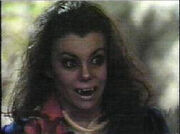
Barnabas Collins, the most featured vampire on Dark Shadows.

A vampire conjured up by the Leviathans.
A vampire is a supernatural creature that has to drink the blood of humans or animals in order to sustain its immortal life. A vampire is a living corpse, commonly referred to as the undead. They were once a living, human being, whom through various circumstances became a victim of vampirism.
Becoming a vampire
In the world of Dark Shadows, there are two known ways of turning a human being into a vampire.
Curse
A powerful witch or warlock can enact a curse, which will transform a living person into a vampire. In almost all instances, this effect is permanent and the curse can only be lifted by the willful action of the original caster (405), although it is more difficult than expected, even when the one who placed the curse is strongly motivated (411).
Vampire bite
A vampire can also be created through the willful act of another vampire. If a vampire drinks blood from a human victim to the point of death, the victim will die and be reborn three nights later as one of the undead. These vampires are usually subservient to the vampire that created them, but there have been accounts where vampires have been shown to be rebellious against their masters.
Powers of the vampire
The vampire has an array of supernatural abilities.
Bite
A vampire possesses two fangs, which they can use to puncture the jugular vein of their victims and drink their blood. Vampires also possess the ability to adequately conceal these fangs when they are in the company of those who are unaware of the vampire’s supernatural identity. How this is done exactly is unknown (perhaps the fangs are retractable) (227).
Turning
A vampire can transform another human being into a vampire. Once this is done, the secondary vampire is traditionally subservient to the primary vampire, mainly because the primary vampire is stronger and more experienced than its unnatural offspring. This is not always the case however, and some vampires, such as Megan Todd and Dirk Wilkins have been known to turn against their masters.
Hypnosis
A vampire has the ability to hypnotize other human beings. In order to do this their victim must stare into the eyes of the vampire. Once the vampire drinks blood from their victim on at least one occasion, (s)he is able to exert this power at will. Once this is done, the victim will fall into a malaise and the vampire can command the thrall to do its bidding (217). Julia Hoffman is the only known victim of a vampire who successfully resisted the "psychic call" of the creature that bit her (566), but the effort evidently proved exhausting. Curiously, at least once a vampire has been known to summon a human being they had not in fact bitten--when Barnabas Collins sought to summon someone to release him from his coffin (701) and later to let Amy Collins know he needed help. If a victim is isolated from the vampire and is not bitten again for some (as yet undisclosed) amount of time, the "spell" fades.
Animal summoning
A vampire appears to have an unnatural affinity when it comes to certain animals. Canines especially can perceive a vampire’s presence and recognize one as being something unnatural. It is possible that a vampire can maintain limited control over such animals and use them to suit their own purposes. Barnabas Collins was known to use packs of wild dogs for eerie effect as a means of frightening people (219, 224). Whether Barnabas was actually controlling these animals to behave in such a way, or whether the animals reacted of their own accord in his presence is unknown. The exact nature of the relationship between a vampire and certain animals has never been fully explored.
Shape-Shifting
A vampire has the ability to shape-shift into the form of a vampire bat. Although the bat in question is larger than the average vampire bat, it is limited by the physical restrictions commonly attributed to such an animal.
Disappearing
Evidently vampires have a kind of ability to teleport, vanishing from one place and appearing elsewhere. Although Angelique did this often when she was a vampire, but had lost her powers as a witch (575), not all vampires demonstrated this power, however, and it apparently is subject to odd limitations. For example, Barnabas Collins could not, nor could the vampire Roxanne Drew use this power from within her coffin. Tom Jennings may have been able to do it, had he not been weakened by the makeshift cross Barnabas was holding over him (631).
Victims
Victims of Vampires are in almost always under their control. A vampire can transform or easily kill its victim (as demonstrated with the characters Gloria and Daphne Collins). Victims sometimes are not turned into vampires. It is only when the vampire takes enough blood from its victim over a long period of time, that they are absolutely drained, then the transformation takes effect. But if a vampire takes a victim in order to satisfy its blood lust and not directly transform them into a fellow vampire then that victim is in danger of dying from natural causes such as blood loss, infection, or even asphyxiation. Most of the women whom Barnabas Collins attacked on the Collinsport docks died natural deaths this way.
Characteristics of a vampire
Becoming a vampire has an adverse effect on an individual’s psyche. As they are considered to be creatures of black magic, it is not uncommon for a vampire to commit acts of deliberate evil. The vampire Barnabas Collins, while by nature a moral person, has routinely committed acts that he would likely not engage in had he not suffered from the curse of vampirism. An example of this would be the abduction and subjugation of Maggie Evans in 1967 (230). Barnabas has also been known to be violently abusive to his servant, Willie Loomis, oftentimes beating him across the face with his silver-handled cane (230). This too seems uncharacteristic of Barnabas, given the background information supplied about him throughout the course of the series.
During the day, a vampire is for all intents and purposes dead.
Vampires cast no reflection in mirrors (288).
Destroying a vampire
There are several known ways of confounding a vampire, or destroying one permanently.
Wooden stake
A sharpened weapon imbedded into the heart of a vampire will destroy them. Traditionally, a wooden stake is the preferred tool for carrying out such a task, but any solid, sharpened object will do, such as a crossbow bolt.
The sun
Exposure to sunlight will destroy a vampire. A vampire can only withstand direct solar radiation for a few seconds before he or she will be forced to find shelter.
The cross
By holding some form of crucifix in front of a vampire, a potential victim can cause the vampire to halt, or even to turn and flee. A cross presented strongly enough can even cause a vampire to be unable to return to their coffin, destroying them at Sunrise (631). Direct physical contact with a crucifix will severely burn a vampire, but will not destroy them. However, it is also a matter of record that at least twice vampires were trapped inside their coffins by placing a cross on their chest.
Holy water
Water that has been blessed by a clergyman will burn a vampire if it makes contact with one. A sufficient supply of such water will likely destroy one entirely.
Silver Bullets
Vampires can be killed by having a silver bullet fired into their hearts.
Curing a vampire
Demonic intervention
Angelique implored Diablos to cure her of her vampirism, saying that complete destruction would be better than this curse (628). He agreed to cure her if she could outwit Nicholas Blair, the Warlock who made her a vampire. Since she was able to return (655, 664) we can assume he chose to cure her rather than destroying her.
Medical technology
The condition of vampirism is as much biological as it is mystical. As early as the 1960s, advancements in modern medicine succeeded in actually isolating diseased “vampire” cells from healthy ones (466-467). The process is a long and arduous one, and requires multiple injections of a specially designed serum in order to have any cumulative effect. Thanks to the contributions of scientists such as Dr. Eric Lang and Dr. Julia Hoffman (490), the curse of vampirism can be successfully exorcised through scientific means. By all accounts, Barnabas Collins is the only existing beneficiary of this radical medical breakthrough.
Once a vampire is cured, they are in effect human again. They can eat, breathe, and go out in the sunlight. They will also age naturally as their body adapts to the new healthy cells. However, a cured vampire is just as susceptible to the effects of vampirism as any other human. There is nothing about the process, which states that a cured vampire cannot once again become one of the undead.
When a vampire is cured, evidently their victims lose all trace of their thralldom, in most cases losing all memory of the event.
Known vampires
The characteristics of a vampire appear to be common to all of the varying continuities of the Dark Shadows mythos.
Dark Shadows (1966) continuity
- Angelique Collins (temporarily)
Dark Shadows (Parallel Time) continuity
Gold Key Comic book continuity
- Barnabas Collins
Paperback Library novel continuity
MGM movie continuity
Dark Shadows (1991) continuity
- Michael Woodard